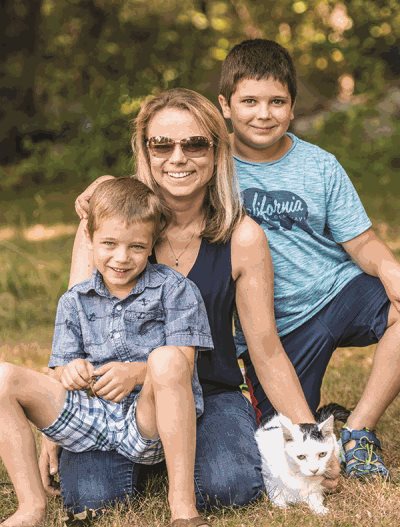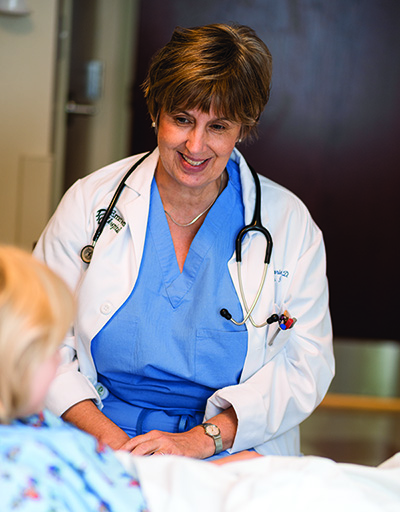 Theo Kollias remembers the bellyache that kept him on the sofa for two days. “It was a big one,” says the Bedford boy, who was six at the time. A stomach bug was going around, so his mother, Emilie Kollias, kept an eye on him and didn’t worry too much — until he began vomiting and complaining.
Theo Kollias remembers the bellyache that kept him on the sofa for two days. “It was a big one,” says the Bedford boy, who was six at the time. A stomach bug was going around, so his mother, Emilie Kollias, kept an eye on him and didn’t worry too much — until he began vomiting and complaining.
“I asked Theo to stand up and jump,” Ms. Kollias recalls, noting that, if he felt sharp pain, it could indicate appendicitis. “He wouldn’t do it; he said it hurt too much. I called his pediatrician, and we drove to the Emerson Emergency Department.”
Theo was quickly examined by Bradley Judson, MD, an emergency medicine physician, who administered pain medication. Mallory Harrison, a member of the Pediatric Intervention Team (PIT), soon appeared with a coping kit, a bag of therapeutic toys that helps children cope with the hospital experience. Theo needed the distraction of bubbles, a Beanie Baby and Hot Wheel truck; his pain was worse, and it took a while for the medication to help.
It was not clear that the boy was suffering from appendicitis, notes Atif Khan, MD, general surgeon. “I was concerned about Theo, because he was getting sicker,” says Dr. Khan, who felt there was a chance his problem was a bowel rupture. “He had shaking chills. Kids can quickly deteriorate; we needed to make a decision.”
Having a CT scan would lead to a diagnosis, but when a child is involved, this merits careful discussion. “I decided I’d rather have Theo exposed to radiation than have him go through unnecessary surgery,” says Ms. Kollias. Emerson radiologists follow Image Gently protocols, which use less radiation when children receive imaging tests.
The test results showed that his appendix appeared to be quite inflamed, and possibly perforated — a process that potentially spreads infection throughout the abdomen. With his parents looking on, Theo headed into the operating room for an appendectomy. “It was traumatic for me,” recalls Ms. Kollias.
Dr. Khan understood completely. “I have a six-year-old daughter,” he says. “It definitely touched me, because I thought of her going through the same thing and needing surgery.” When the 30-minute procedure was complete, Dr. Khan informed Theo’s parents that his appendix had perforated. After removing Theo’s appendix — a small pouch that protrudes from the large intestine — Dr. Khan washed out the area and used sutures to close the incision.
Before long, climbing trees again
Theo remembers waking up after surgery. “Straight away, I looked at the scar,” he says. “They drew on my belly with a marker. The real problem was sitting up. It hurt.” He didn’t eat for the first day or so and was given antibiotics and pain medication.
Between 7 and 10 percent of the population develops appendicitis — an infected appendix — at some point in their lives. Regardless of one’s age, there is a risk for complications after surgery, especially if the appendix perforated. “We watch for infection, abscess or ileus — where the gastrointestinal tract temporarily shuts down,” says Dr. Khan. “We like patients to stay on a liquid diet until we’re sure they have not developed ileus.”
 Emerson has a 24/7 pediatric hospitalist service that is available to see surgical patients for anything related to their medical care. “We can help manage the child’s pain and give advice regarding the appropriate dose of intravenous fluids and medications,” says Inger-Marie Pu, MD, (pictured at right) who directs the pediatric hospitalist service. “Sometimes a child has an underlying medical condition that is best cared for by a pediatrician. We help with the medical issues while the surgeon takes care of the acute surgical issue.”
Emerson has a 24/7 pediatric hospitalist service that is available to see surgical patients for anything related to their medical care. “We can help manage the child’s pain and give advice regarding the appropriate dose of intravenous fluids and medications,” says Inger-Marie Pu, MD, (pictured at right) who directs the pediatric hospitalist service. “Sometimes a child has an underlying medical condition that is best cared for by a pediatrician. We help with the medical issues while the surgeon takes care of the acute surgical issue.”
The pediatric hospitalists provide another service that parents appreciate. “We communicate with the child’s pediatrician in the community,” she notes. “We consider ourselves to be an extension of the child’s pediatrician while they are at Emerson.”
Theo was happy to see Ms. Harrison the morning after his surgery. “She brought me a PlayStation and a DVD player,” he says.
“We often debrief with children who have surgery by asking them about their experience,” says Ms. Harrison, noting that the PIT’s focus is the emotional care of children, as well as their families. “We might ask ‘What was the hardest part? Were there any surprises? Was there a good part, too?’”
Once at home again, Theo stayed out of school another week while his incision healed and he regained his energy. He discovered that having surgery wasn’t so bad. “I got two Lego sets, and my whole class sent me get well cards,” he says.
Pretty soon, he was climbing trees again. “After Theo was home from the hospital two weeks, I could take my mind off him,” says Ms. Kollias, who is pleased with the care at Emerson. “We’ve brought Theo and his brother, Alexander, to the Emergency Department before — for smashed fingers, stitches and sprains.”
Looking back, Theo understands what his “big bellyache” was about. “When you have appendicitis, you have pain, you can’t walk very well, and you have a scar afterwards,” he says. “But I’m not going to have appendicitis again.”
Pediatric specialties are expanding at Emerson
There are many outstanding pediatricians who are affiliated with Emerson Hospital. During the past few years, they have been joined by numerous pediatric specialists. These clinical experts have offices in the community, which makes life easier for patients and families.
John Cahoy, MD, PhD, a pediatric orthopedic surgeon, joined Emerson this past summer. Dr. Cahoy provides comprehensive orthopedic care of children from birth to young adulthood. His clinical interests include pediatric upper and lower extremity fractures, treatment of athletic injuries and overuse syndromes and non-surgical management of adolescent scoliosis and spine conditions.
Jennifer Setlur, MD, an otolaryngologist (ear, nose and throat specialist) with Mass Eye and Ear, Concord, provides the kind of care that children often need, including inserting ear tubes, removing tonsils and treating airway problems, right in the community.
Four pediatric ophthalmologists, from D’Ambrosio Eye Care and Lexington Eye Associates, are affiliated with Emerson.
Mass General Hospital for Children has arranged for several pediatric specialists to provide care at Emerson in the following specialties: cardiology, endocrinology, gastroenterology, nephrology and pulmonology. Ira Skolnik, MD, PhD, a well-known dermatologist who sees adults and children, is one of only a handful of dermatologists in the U.S. who is triple-board-certified in pediatrics, dermatology and pediatric dermatology.
Children who come for testing, procedures or surgery and stay on Wheeler 4, the hospital’s pediatric unit, are the focus of the pediatric hospitalists. These highly regarded physicians are found anywhere children receive care, including in the Emergency Department. They attend births when necessary and care for newborns.
Similarly, the Pediatric Intervention Team (PIT) is a staff of three, including a nurse practitioner who specializes in child and adolescent psychology. They make the hospital experience easier on the pediatric patient and the family and also bring in a consulting child psychiatrist when appropriate.
Top photo caption: (Left to right) Theo Kollias with his mother, Emilie, brother, Alexander, and Monk the cat. The two boys have been to the Emerson Emergency Department on a few occasions.

